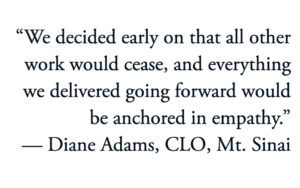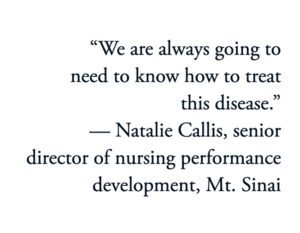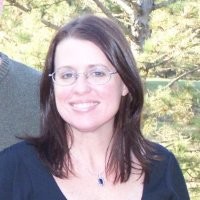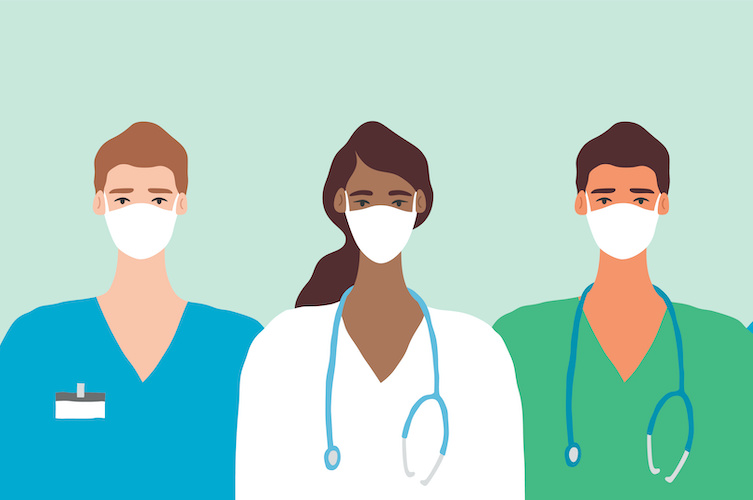
When COVID-19 hit the United States., New York was the first state to reach crisis levels. By late April, the state had almost 250,000 cases and more than 14,000 deaths. Hospitals were running out of ventilators, beds and protective equipment, and hospital staff were in crisis mode as they tried to care for the endless flow of patients.
“Everyone had to pivot overnight,” said Diane Adams, chief learning officer of Mt. Sinai Hospital in New York City. “One Friday in March we were discussing our next face-to-face orientation program, and by Sunday, it was a tsunami.”
Adams’ team had to figure out how to train all of the nursing staff to treat COVID patients, including many who had never worked in intensive care before. And the training had to be delivered quickly, remotely, and in a time when everyone was overworked and overstressed. “We decided early on that all other work would cease, and everything we delivered going forward would be anchored in empathy,” she said.
We’d like to help
Adams’ team committed themselves to supporting hospital staff as they adapted to the COVID crisis. They initially shifted new-hire orientation to video learning and began offering updates on the latest COVID treatments for staff being moved to intensive care. The team also manned a 24/7 coaching hotline for staff to call if they ran into problems while treating patients.
But the demand for learning was so high, they had trouble keeping up.
Then Adams received a call from Sana Labs, a small learning technology company in Stockholm, Sweden, that uses artificial intelligence to create adaptive virtual learning programs.
 “We saw the pandemic and wanted to help people on the front lines,” said Jon Lexa, director of operations for Sana Labs. One of his company’s co-founders knew the president of Mt. Sinai through their work at the New York Academy of Science, so they reached out to offer their services to the hospital free of charge.
“We saw the pandemic and wanted to help people on the front lines,” said Jon Lexa, director of operations for Sana Labs. One of his company’s co-founders knew the president of Mt. Sinai through their work at the New York Academy of Science, so they reached out to offer their services to the hospital free of charge.
“This kind of technology isn’t usually available to nonprofit,” Adams said. “It was a very generous offer.”
Lexa noted that Adams was initially hesitant to get a free offer of training from a company she’d never heard of, but she “took a leap of faith.” After a few discussions, the two organizations began working remotely to develop a personalized learning curriculum for the virtual platform that would enhance the skills of nurses treating COVID-19 patients across the hospital.
The overarching goal of the project, dubbed “Project Florence,” was to find a way to rapidly upskill nurses from a variety of backgrounds to care for patients with symptoms they had never seen in this kind of combination before.
Teams from Sana and Mt. Sinai were working around the clock to transform the classroom content into short, engaging, self-paced learning content. “They were in New York and we were in Stockholm, so we used a lot of online collaboration tools to get it done,” Lexa said. He noted that his team are experts in learning design technology, but they have no clinical background. So they relied on Mt. Sinai’s subject matter experts to provide the material and to review every piece of content and quiz question to be sure they were relevant and applicable.
Training transformation in just two weeks
The self-paced content is based on roughly 20 hours of linear content originally developed by Mt. Sinai. The content was designed to be taught in a classroom, primarily to intensive care nurses. To build the virtual courses, Lexa’s team would first create a chunk of content based on the materials, then return it to Adam’s team for edits. Then his team would make the revisions, and send it back again. “We were going back and forth 24-7,” he said.
This final curriculum features nine modules including topics such as how to put on personal protective equipment, how to adjust ventilator settings and how to recognize signs of acute respiratory syndrome. To make the lessons more engaging, Sana included videos, graphics and hover-over settings with pop-up chunks of information. All of the lessons adhere to guidance from national nursing organizations and include links to additional resources.
But transforming the existing content for virtual access wouldn’t solve all of Mt. Sinai’s needs. The huge demand for COVID care meant nurses were being pulled from across the hospital to treat COVID patients, and they all brought different skills and experiences to the process, said Natalie Callis, senior director of nursing performance development. “So it was important that we could tailor the learning quickly.”
To accommodate the varying needs of learners, Sana’s technology uses AI to determine which pieces of content learners need to close their personal skill gaps, and what content they can skip. To reduce the risk that nurses would guess the right answer on a topic they don’t fully understand, the assessment includes multiple questions on each topic. “They might guess one answer correctly, but they are unlikely to guess the right answer two or three times,” Lexa explained.
Based on the assessment results, the platform recommends what modules they need to complete, then it lets them navigate that content at whatever pace they need. Learners can skim modules that are familiar and spend more time in areas where they need additional help. They can also replay videos or return to any lesson as many times as they need to gain confidence in the material. At the end of each module they complete a quiz to verify the learning.
 Some nurses finish it in a couple of hours, others spend two days reviewing all the material in depth, Callis said. They can also start and stop whenever they need to and the system always returns them back to exactly where they left off. This was important back in April because these nurses rarely had free time to sit with the content for hours.
Some nurses finish it in a couple of hours, others spend two days reviewing all the material in depth, Callis said. They can also start and stop whenever they need to and the system always returns them back to exactly where they left off. This was important back in April because these nurses rarely had free time to sit with the content for hours.
The nurses love the training. “The feedback we are getting is that it is timely, relevant and easy to use,” Callis says.
And even though New York is well past its peak of COVID patients, Mt. Sinai continues to offer it to new and existing nurses and other healthcare workers to ensure they are prepared for the next wave. “We are always going to need to know how to treat this disease,” Callis said.
Who needs training?
Sana is now making Project Florence available free-of-charge to hospitals around the world, and nurses are spreading the word via their own networks, LinkedIn and social media groups. “We are doing mission-driven work, and we need to help more than just our own nurses,” Adams said. She encourages any health care center dealing with COVID-19 patients to consider using the training with their own staff.
Many of them are following her good advice. By early August, more than 2,700 nurses and other health care professionals had completed the training in hospitals across the U.S. and Europe, as well as Japan, Brazil, Colombia and Saudi Arabia. And more are signing up every day, Lexa said. Hospitals can sign up for access to the free platform and curriculum at www.sanalabs.com/projectflorence.
Sana is now working with teams at other hospitals to adapt the content for their language and practices, and to add additional content as knowledge about the disease evolves. “We love to see nurse educators author new content based on what they have learned about COVID,” he said. “It feels like we are making an impact.”
“It’s hard to measure success in a crisis,” Adams added. But in talking to her nurses and seeing how well they are caring for Mt. Sinai’s COVID patients, she agrees that the training has been a great success.















